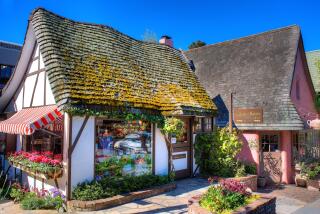PROVINCETOWN : A VILLAGE SHAPED BY THE SEA
- Share via
The sea is calm tonight.
The tide is full, the moon lies fair
upon the straits. . . .
The British poet Matthew Arnold wrote that in his poem “Dover Beach.” He was speaking of the coast of England; the straits he mentions is the English Channel.
But his lines could be applied to Provincetown, far out on the tip of Cape Cod at the eastern end of Massachusetts. The sea off the coast is often calm, and when the moon is high the waves offshore sparkle like jewels.
From the time, early in this century, when Provincetown was the locale of experimental theater, when Eugene O’Neill and Edna St. Vincent Millay burned the candle at both ends, the town, mostly in summer, has been a seething, noisy, exasperating, colorful and fascinating little place.
Choose your own season. It has something for everybody at all times of the year.
In some ways the town is like an island. Lying as it does on the tip of the cape, it has become self-contained. From the mainland at Buzzard’s Bay you head east past Hyannis, then north past Wellfleet, Truro, North Truro, past long stretches of sand dunes that are now part of Cape Cod National Seashore.
Then you are on Commercial Street, which is one-way along the waterfront. Suddenly, dunes vanish. You are on a most picturesque street. Lined on both sides with shops and small houses, you might feel that this is a village in England transplanted to these shores.
Organic food stores abound, because one thing must be said of the young people who raise hell here--they despise smoking, fast food, sweet soft drinks, hard liquor, candy. At least a portion of them do.
There are many organic food stores, as well as restaurants that serve the same food as each other. In between are the “regular” restaurants, clothing stores with jeans, big bulky sweaters, high boots, granny dresses, wide belts with studs, black leather motorcycle jackets.
Some stores sell artwork, a lot of it created right here. Most of it is merely passable, of course, but occasionally your eye might settle on a painting that makes you look twice. The Leonardo da Vincis are few, but once in a while you see the work of a real artist. If you have the eye for good art, buy one of these paintings or sculptures; years from now you may be the owner of a masterpiece.
Commercial Street runs roughly east and west along the shore. U.S. 6 parallels it a few blocks north. The two are connected by little side streets, most of them no more than two or three blocks long.
The charm of these streets lies in the houses that line them. Many are private homes. Some, the larger ones, have been turned into rooming houses. Most have a rustic Victorian/Colonial air about them.
They sit on postage stamp-size lots. Land here is a rare item. Each house has a tiny plot that in summer and fall is covered with flowers if the inhabitants care--and weeds if they don’t.
These side streets are a pleasure to stroll along. Choose any at random. Start near the Pilgrim Monument, the 255-foot tower in the center of town, built to commemorate the landing of the Pilgrims. It claims to be the tallest granite structure in the United States.
Tall it is. If you feel energetic, climb to the top. The view is worth it. On a clear day you can see across the bay to Plymouth on the western shore of Cape Cod Bay.
The town radiates outward from the Pilgrim Monument. Nearby is the chamber of commerce. Along Commercial Street is the endless chain of eating places.
Explore the side streets on foot. Try going up Standish Street, which leads to the cemetery and its headstones with dates centuries back. Thread your way in and out--a block here, a block on Commercial, two blocks up another side street.
If you have a lively sense of curiosity you will find many enchanting sights--a house with intricate gingerbread woodwork; a tiny shop that sells clothing, another a gallery of sculpture; here a tiny grass plot with a handmade schooner model on it; an old picket fence sagging with age but beautifully grayed by the weather.
Everywhere in these small streets you will get the flavor of the sea. It’s in the air; what you breathe is clean, salty, tangy. And beyond that is the atmosphere. You almost expect to see Long John Silver come stomping out of a small weathered tavern or Capt. Kidd materialize from a dark alley. It seems almost strange to hear American English spoken; the ambiance seems to call for a Cockney accent.
Relax on MacMillan Wharf, from which fishing vessels and charter boats put out. It provides a good view of the rocky beaches, the ocean and Long Point Lighthouse almost directly opposite. Sea gulls swoop with a grace that is as much poetry as flight.
At the far west end of Commercial Street a bronze plaque is set in a boulder that commemorates the spot where the Pilgrims first set foot in this hemisphere before going on to Plymouth.
The Oldest House is at 72 Commercial St. Built in 1746, it is open every day from June through October, 10 a.m. to 5 p.m. It is a fine example of what is called a Full Cape House, with an air of a ship’s cabin in some of its rooms.
Behind the town hall is a bas-relief model of the Mayflower Compact, written and signed while the ship was at anchor here. This was the first American law, or act, passed in this country, and it led, because of the democratic principles inherent in it, to the Declaration of Independence.
The many art associations and museums are open at varying times; if your trip is going to involve these galleries you’d do well to write to the address below for the hours they keep.
And if seafood is one of your pursuits, several restaurants vie to make you happy. They are near MacMillan Wharf, and any storekeeper will tell you of the good ones, and so will the chamber of commerce.
All information from the Provincetown Chamber of Commerce, 207 Commercial St., P.O. Box 1017, Provincetown, Mass. 02657, phone (617) 487-3424.
More to Read
Sign up for The Wild
We’ll help you find the best places to hike, bike and run, as well as the perfect silent spots for meditation and yoga.
You may occasionally receive promotional content from the Los Angeles Times.






